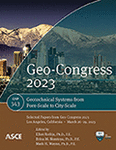Effect of Soil Structure Interaction on the Design of Tall Concrete Buildings
Publication: Geo-Congress 2023
ABSTRACT
This paper presents the effect of soil-structure interaction on tall buildings’ design and straining actions. This investigation was carried out by analyzing a multi-story building via a direct approach using a 3D finite element model for the soils and the structure. The results are compared with traditional sub-structuring methods that use linear subgrade reaction springs to represent the soil. The results are also compared with the less common sub-structuring approach that adopts nonlinear springs to represent the soil-structure interaction. Two parametric analyses are performed under gravity loads considering different soil characteristics. The effects of soil-structure interaction and the induced differential settlement are presented for various loading conditions and straining actions on the structure-supporting elements. The conclusions include the limitations and advantages of the common sub-structuring approach and the effects of soil non-linearity on the behavior and design of tall buildings.
Get full access to this article
View all available purchase options and get full access to this chapter.
REFERENCES
Allievi, L., Ferrero, S., Mussi, A., Persio, R., and Petrella, F. (2013). Structural and geotechnical design of a piled raft for a tall building founded on granular soil. Proceedings of the 18th international conference on soil mechanics and geotechnical engineering, Paris.
Azadi, M. R. E., and Soltani, A. A. (2010). “The effects of soil-foundation-structure interaction on the dynamic response of Delijan cement-storage silo under earthquake loading.” Electronic Journal of Geotechnical Engineering 15: 659–676.
Biot, M. A. (1937). Bending of an infinite beam on an elastic foundation.
Bowles, J. E. (1988). Foundation analysis and design.
ECP-201. (2012). Egyptian Code for Calculating Loads and Forces in Structural Work and Masonry. National Research Center for Housing and Building, Giza, Egypt.
ECP-202. (2001). Egyptian code for soil mechanics Design and Construction of Foundations. National Research Center for Housing and Building, Giza, Egypt.
ECP-203. (2020). Egyptian Code for Design and Construction of Concrete Structures. National Research Center for Housing and Building, Giza, Egypt.
Filonenko-Borodich, M. (1945). “A very simple model of an elastic foundation capable of spreading the load.” Sb. Tr. Mosk. Elektro. Inst. Inzh. Trans 53.
Hosseinzadeh, N., Nateghi-Alahi, F., and Behnamfar, F. (2004). “Shake table study of soil-structure interaction effects on seismic response of adjacent buildings.” Comput. Methods Eng 22(2): 51–71.
Iqbal, A., and Al-Hussaini, T. (2014). “Soil-structure interaction effects on tall buildings with mat foundation.” SESOC Journal 27(2): 48–60.
Jia, Q., Meng, X., and Zhang, X. (2011). Numerical Analysis of Foundation Settlement for a Fifteen-Story Moving Building. Advanced Materials Research, Trans Tech Publ.
Kerr, A. D. (1964). Elastic and viscoelastic foundation models.
Magade, S., and Patankar, J. (2008). Effect of soil structure interaction on the dynamic behavior of buildings. Second international conference on emerging trends in engineering (SICETE). IOSR Journal of mechanical and civil engineering, Pune.
Mohasseb, S., Ghazanfari, N., Rostami, M., and Rostami, S. (2020). “Effect of soil–pile–structure interaction on seismic design of tall and massive buildings through case studies.” Transportation Infrastructure Geotechnology 7(1): 13–45.
Newmark, N. M. (1935). Simplified computation of vertical pressures in elastic foundations. Engineering Experiment Station. University of Illinois at Urbana-Champaign.
Pasternak, P. (1954). “On a new method of an elastic foundation by means of two foundation constants.” Gosudarstvennoe Izdatelstvo Literaturi po Stroitelstuve i Arkhitekture.
Poulos, H. G., and Badelow, F. (2015). “Geotechnical parameter assessment for tall building foundation design.” International Journal of High-Rise Buildings 4(4): 227–239.
Ramadan, O., Al-Anany, Y., and Sanad, A. (2012). Effects of Soil-Structure Interaction on Nonlinear Seismic Response of Buildings. the 15th World Conference on Earthquake Engineering.
Suhas, K., and Prakash, D. (2017). “Effect of structure-soil-structure interaction on seismic response of adjacent buildings.” International Journal of Engineering Research & Technology (IJERT).
Terzaghi, K. (1955). “Evalution of conefficients of subgrade reaction.” Geotechnique 5(4): 297–326.
Tongaonkar, N., and Jangid, R. (2003). “Seismic response of isolated bridges with soil–structure interaction.” Soil Dynamics and Earthquake Engineering 23(4): 287–302.
Vesic, A. B. (1961). Beams on elastic subgrade and the Winkler’s hypothesis. Proc. 5th Int. Conf. on SMFE.
Information & Authors
Information
Published In
History
Published online: Mar 23, 2023
Authors
Metrics & Citations
Metrics
Citations
Download citation
If you have the appropriate software installed, you can download article citation data to the citation manager of your choice. Simply select your manager software from the list below and click Download.
